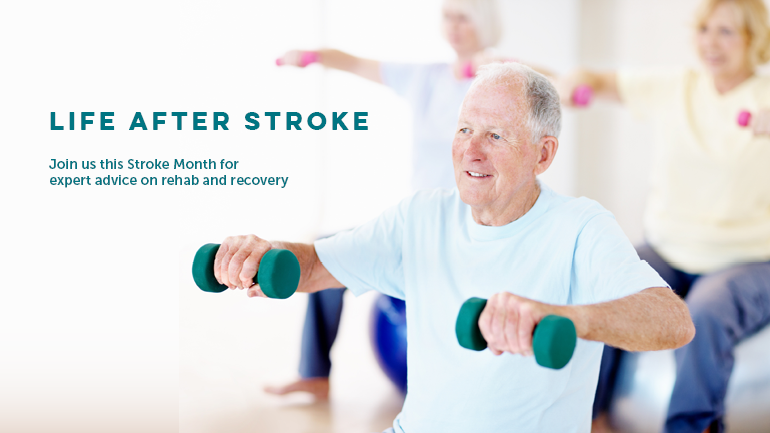
Recovery from a stroke for most people is a life-long process.
Recovery from a stroke for most people is a life-long process. We now know with the discovery of neuroplasticity that stroke survivors continue to make progress and change their brains throughout their lives. It is important as a stroke survivor to set aside time to look back on your past recovery achievements and to continue to set new goals as you move forward in your recovery.
Maintaining your momentum
Within the health care system, rehabilitation programs are designed to support stroke survivors to maximize their recovery in the first year after a stroke. Making the jump from a supportive outpatient rehabilitation program to continuing recovery at home can be a difficult transition for some people. Recognizing this, the Rehab Program in Fraser Health has actively partnered with a variety of community organizations over the last six years to support the development of community-based programs which can support stroke survivors during this transition.
Social connections
A common concern shared by stroke survivors is that they often feel isolated after they leave the hospital. Once they are home, they have a desire to connect with others in their community who have experienced a stroke. The good news is there are programs to help you connect. The Stroke Recovery Association of B.C. offers a variety of different services in communities across British Columbia. They are a non-profit organization and they focus on “assisting stroke survivors and their caregivers throughout the province to improve their overall quality of life.”
In 2014 the Heart & Stroke Foundation began to implement their Living With Stroke program. These are community-based workshops that are facilitated by volunteers familiar with stroke. The focus of these workshops is to allow stroke survivors and their care partners to connect with others while providing supportive and educational programming in communities across British Columbia.
Physical exercise
It is recommended that adults set aside time to do some sort of continuous moderate physical activity three to four times per week for 30 to 40 minutes. The important factor here is continuous. Going for a moderately paced walk three to four times per week will meet this need. When you are exercising moderately you should be able to carry on a conversation without losing your breath.
Depending on your functional abilities there are numerous programs in the community to help you achieve these activity recommendations. One program that Fraser Health has been involved with developing is the T.I.M.E. program (Together In Movement and Exercise). This program is specifically designed to support people in the community who have some loss of function secondary to a neurological injury and is a very good program for clients who have some difficulty in mobilizing after their stroke. (To attend, you must be able to walk for 10 meters with an aid.)
Tips for successful stroke recover
- Don’t compare progress. Every stroke is unique. Every brain is different, and the cause, location and size of every stroke is different. It is not helpful to compare yourself to somebody else who has had a stroke. Take the time to track and appreciate your own progress.
- Challenge yourself. Continue to challenge yourself and set new SMART goals. SMART goals are Specific, Measurable, Achievable, Realistic and Time-bound.
- Take charge of your health. Monitor your blood pressure and share this information with your doctor. Your target blood pressure should be below 135/90. Blood pressure fluctuates through the day: what is important is your average blood pressure over multiple readings. Take your blood pressure at random times to get truer readings.
- Listen to your body. Fatigue is a common complaint after stroke. Your brain needs sleep and rest to heal. It is better to rest than to push yourself to do more when you are feeling tired.
- Find balance. The art of stroke recovery is finding a way to push yourself to do a bit more every day while striking a balance with finding the time to rest and recover in between.
- Eat healthy. It is important to reduce salt and cholesterol. Think of your plate as being made up of four quarters. Two quarters devoted to fruits and vegetables, one quarter devoted to meat, and one quarter devoted to rice, bread, grains or potatoes.
- Get active. The recommended level of activity is a minimum of moderate exercises three times per week for 30 to 40 consecutive minutes. During moderate exercise you should be able to comfortably have a conversation during your activity.
- Walk to recover. Walking is excellent exercise – set SMART goals to slowly improve your time and distance as an easy, accessible way to meet your activity goals.
- Be careful with substances. Smoking, alcohol, herbal supplements, over the counter medications and illicit drugs can all negatively impact your recovery following a stroke. If you take any, be sure to discuss their impact in detail with your doctor and pharmacist.
- Limit your stress. Stress negatively impacts recovery. The key is recognizing what causes you stress and learning healthy strategies for mitigating its effects. Exercise, mindfulness, meditation and socializing have all been shown to reduce the impacts of stress on the body.
